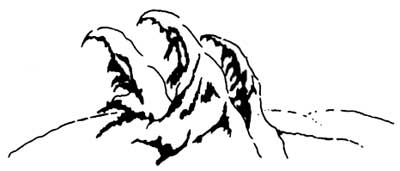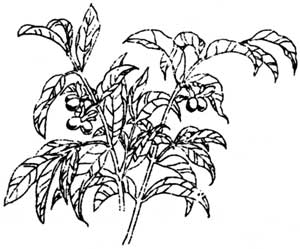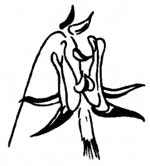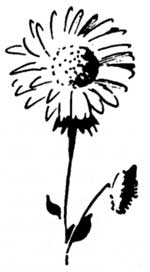|
Volume XXVI - 1995
A Naturalist's View of Crater Lake Lodge
By Erik Hendrickson and Steve Mark
The Crater Lake Lodge will reopen in the spring of 1995 after four
years of rehabilitation work. There are just 71 guest rooms in the
lodge, but all park visitors are welcome to spend some time in the
building. They can relax in the Great Hall, have a meal in the dining
room, examine a small exhibit room that centers on the lodge's history,
or wander around the grounds to contemplate Crater Lake and its
surroundings. As you might expect, there are many opportunities for
observation and study.
Landscaping adjacent to the lodge is a lesser-known component of a
more than $15 million rehabilitation project. A separate landscape
contract has been let in order to restore lodge grounds impacted during
four summers of construction. In addition to historic and aesthetic
criteria, the landscape plan addresses erosion and species integrity as
two other areas of emphasis.
The effects of erosion can be seen just below the caldera rim. Roots
of mature trees are exposed where the soil in which they grew has been
worn away. Small-scale erosion in areas disturbed during construction
and in newly planted beds is being checked by an erosion control
blanket. This consists of wood shavings and a nylon net that will
degrade in a few years with exposure to ultraviolet light. Concerns that
the net might entangle deer have been alleviated upon observations that
the animals traverse the blanket without difficulty.
The genetic integrity of plants placed around the lodge became a
prime concern of consulting botanists. They insisted that vegetation
planted in the restored landscape be limited to the floral gene pool of
Crater Lake National Park. This would insure better adaptation for
survival in the harsh environment (deep snows, long winters, dry
summers, high elevation) of Rim Village, but also might prevent
introduction of non-native species or variants which eventually could
compete with native plants. All of the plants used in this project have
been propagated from seed collected in the park, or from local
cuttings.

Young hemlocks curl over as snow accumulates.
Illustration by Amy Mark, National Park Service files.
All three tree species evident around the lodge are well adapted to
the deep snows that fall at Crater Lake. Mountain hemlock, Tsuga
mertensiana, with its distinctive droopy leader, is very flexible.
Visitors in late fall or early spring might see young hemlocks curling
over as snow accumulates, or slowly springing upright as the snow melts.
Subalpine fir, Abies lasiocarpa, has also evolved to bend with
heavy snow and strong wind. Mature trees display a distinctive
spire-like silhouette, in part to shed snow and cut wind resistance.
Whitebark pines, Pinus albicaulis, can be identified by clusters
of five needles and very limber branches. They are often perched right
at the caldera's edge because their ecological niche permits survival in
exposed areas where there is less competition from other species.
Contractors also transplanted a number of shrubs into beds around
the lodge. Perhaps more than the trees, shrubs help blend the hotel with
its surroundings because they can soften vertical lines imposed by
building facades and provide transition between ground and structure. In
utilizing a number of well adapted shrubs around the Crater Lake Lodge,
this also provides a way to learn something about native plants.
Discovered only in 1896, the Crater Lake currant, Ribes
erythrocarpum, is found in only a few areas outside park boundaries.
This is a creeping shrub, and may form a large mat with copper-colored
flowers in July and red berries in late summer. Waxy currant, Ribes
cereum, by contrast, is more bushy and has smoother leaf edges. It
can also be distinguished by white or pinkish flowers and yellowish red
berries. Botanists found the waxy currant much easier to propagate from
in-park sources than Crater Lake currant, perhaps because of its wide
distribution at high elevation in dry, open places.
Pinemat manzanita, Arctostaphylos nevadensis, is a low,
sprawling shrub that seldom grows more than a foot high. It has red bark
on its slender stems, and evergreen, leathery leaves. This type of
manzanita is also common along the Cleetwood Cove Trail leading down to
the lake. It is one of several shrubs frequently browsed by deer.
Rubber rabbitbrush, Chrysothamnus nauseosus, is a relatively
small shrub, being six inches to two feet in height. Its yellow flowers
appear late in the summer and can be seen along the Garfield Peak Trail
and at places like the Wineglass near the caldera's edge.

black twinberry
L. Howard Crawford, Nature Notes
from Crater Lake, Vol. 8, No. 3 (September 1935), p. 7.
|
Sierra willow, Salix sitchensis, and Bush honeysuckle,
Lonicera involucrata, both have long, large leaves, but they are
easy to tell apart in the late summer. The willow, which ordinarily
prefers wet habitats such as stream sides, develops seeds that give the
appearance of small bits of cotton. Bush honeysuckle (which is sometimes
called black twinberry) produces pairs of dark purple berries which are
a favorite food of the Clark's nutcracker, Nucrifraga columbiana.
These berries can stain the bird's beak bright purple, something which
is often seen around Rim Village where this species of honeysuckle is
common.
Botanists experienced difficulty in locating Mountain maple, Acer
glabrum, from which cuttings could be obtained in the park. They
eventually found several of these shrubs in a moist area near the east
rim drive. As a result, several mountain maples can be seen near the
southwest corner of the kitchen.
Mountain ash, Sorbus sitchensis, is fairly common around the
lodge. Shrubs planted in the 1930s are about five feet tall, and in need
of pruning. The leaves of mountain ash are composed of seven to eleven
leaflets end have a shiny green color. This shrub produces red berries
in the fall that are eaten by migrating cedar waxwings, Bombycilla
cedrorum.
Although they are the smallest component of the landscape project,
perennial wildflowers are, at times, its most colorful. Like the shrubs,
these herbs provide an understory for trees and complement the
grass-like native sedges. From midsummer until late fall, a number of
perennial wildflowers transplanted into beds around the lodge may be
seen.

columbine
Walter Rivers, Crater Lake Nature
Notes, Vol. 14, No. 1 (1948), p. 11.
|
As its name implies, the pearl-everlasting, Anaphalis
margaritacea, has a long-lived flower. Its papery-white petals
appear in July and last until snowfall. Growing from one to two feet
tall, it is commonly seen along park roads where runoff creates moist
conditions.
Visitors from the Rocky Mountains who are familiar with the pastel
to deep blue of columbines in that region may be surprised to find the
red and yellow Sitka columbine, Aquilegia formosa, around the
lodge. This species of columbine is the only one in the park, but is
common to forests along the Pacific slope. It is frequently seen during
July and August in the Cascade Crest Wildflower Garden near Park
Headquarters.

cascade aster
Rivers, op. cit.
|
Cascade aster, Aster ledophyllus var. covillei, has purple
flowers with approximately eight radiating petals. This is the most
common of the four asters in the park and was easily propagated from
seed for transplanting at the lodge. It is often seen from July to
September around the rim, usually in dry places.
Sulfur eriogonum, Erigonum umbellatum, is found in dry areas
throughout the park and is sometimes known as wild buckwheat. This plant
has small yellow flowers atop a leafless four to twelve inch stem. Its
paddle-shaped, silver green leaves appear at the base. Another member of
this genus, Eriogonum pyrolaefolium var. coryphaeum, is somewhat
similar in appearance but has white flowers. E. pyrolaefolium is
usually known as Dirty socks because of its objectionable odor.
Cliff penstamon, Penstamon rupicola, is an attractive woody
plant with purplish pink flowers that grows in rock crevices. Often
found on ledges along the Garfield Peak Trail, cliff penstamon has been
planted in the rocks which help stabilize the rootball of a mountain
hemlock transplanted at the east end of the lodge.
As intended, the trees, shrubs, and flowers around Crater Lake Lodge
combine to help blend the building with its surroundings. Although they
represent only a small part of the park's flora, these species are also
useful starting points in demonstrating how organisms adapt to exposed
places at higher elevations. If nothing else, the plants adjacent to
Crater Lake Lodge demonstrate that life can persist in an environment
where natural succession is slow or even absent for long periods after
disturbances occur.

Amy Mark, NPS files
Erik Hendrickson is a structural engineer with the National
Park Service in Denver, Colorado. He helped direct the rehabilitation
of Crater Lake Lodge.
Steve Mark is the park historian at Crater Lake. He has been
editor of Nature Notes since its revival in 1992.
|

